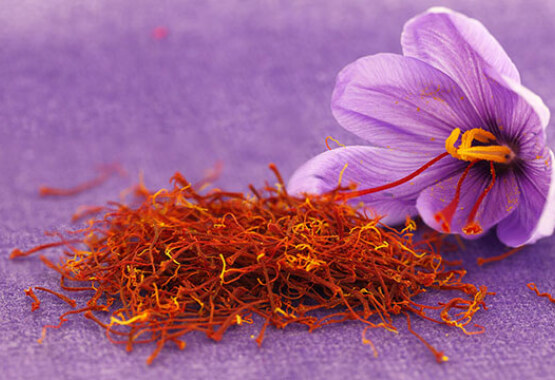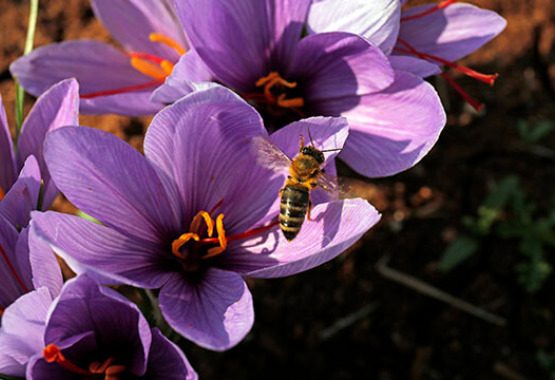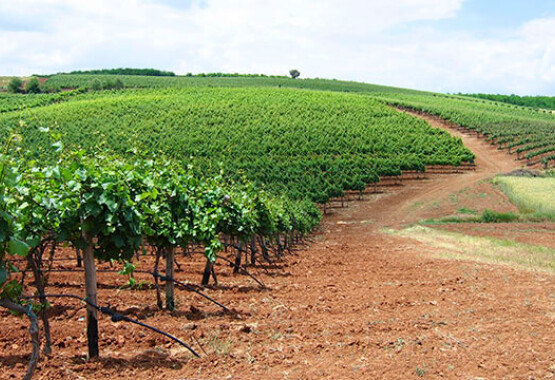
KOZANI
During its heyday, the area of vineyards exceeded 4,000 hectares, which gradually decreased to 2,600 in the 1970s, reaching the current approximately 1,300 hectares. Over time, the varietal composition changed, with Xinomavro and Moschomavro -the first one mostly- retaining the dominant position. The old and lesser known varieties, such as Pitsiariko, Vapsa, Voulgariko Siatistas and Voulgariko Pelekanou, Alpitsa, Nigrikiotiko, Sklithro, Kokkinouska, gave way in favour of the more recognisable Cabernet Sauvignon, Merlot, Syrah, Chardonnay Gewurztraminer, Assyrtiko, Malagouzia, and others.
The Siatista Protected Geographical Indication has been recognised since 1993, and covers white dry wines like Batiki, Xinomavro, Priknadi and Gewurztraminer, rosé and red wines including Moschomavro, Xinomavro, Chondromavro, Cabernet Sauvignon, Cinsault and Merlot, as well as sweet ‘liasta’ wines (called ‘iliasta’ by the locals) produced by partial dehydration of the grapes in the sun or more usually in the shade. The latter, which are aged for several years in barrels, are the pride and joy of Siatista, although there are also very interesting samples of local white and red dry wines in the area.
The Velventos Protected Geographical Indication (PGI) was recognised in 2000 and includes only dry wines of all three colours. The PGI covers the whites including Assyrtiko, Malagouzia, Batiki, Roditis and Chardonnay in any proportion; the rosé include varieties such as Roditis, Xinomavro, Moschomavro, Limniona, Cabernet Franc, Cabernet Sauvignon, Merlot and Syrah. The PGI reds are Xinomavro, Moschomavros, Merlot, Limniona, Cabernet Franc (whose local clone is called Tsapournakos), Cabernet Sauvignon and Syrah, again in any proportion.
The Velventos wines have become renowned in recent years, thanks to their personality and quality.
The PGI Kozani, recognised in 2008, produces dry, semi-dry and semi-sweet wines, of all three colours, throughout the regional unit. These include white wine varieties, in any proportion, like Malagouzia, Roditis, Batiki, Priknadi, Chardonnay, Ugni blanc (Trebbiano), Xinomavro and Gewurztraminer. The red and rosé wines are produced from Moschomavro, Limnio, Xinomavro, Merlot, Cabernet Sauvignon, Cinsaut and Syrah, with the participation of Roditis variety in the rosé wines.
There are three wineries in Kozani that can be visited on the Wine Routes network of northern Greece, and on the Lakes route in particular. One is located in Siatista and the other two in Velventos.
Meet the local ‘vrasta’ wines
The vrasta wines (meaning boiled), which are found mainly in Eratyra and Pelekanos, are a particularity, and their production involves some very old winemaking techniques, which are common in many parts of Greece. These are sweet wines, produced either by adding grape must (serbeti) that is super-concentrated through intense fermentation, before the second fermentation process begins, or, by fermenting the entire amount of grape must until its volume is reduced by about 20%, before the second fermentation starts. They can be sampled only locally.
The wines of Kozani
The lake routes
Grapevine cultivation in the area of Kozani is rooted deep in the past; there are records of vineyards in Ottoman tax registers, as well as in codices, that go back to the 16th century. Moreover, later travellers of the 19th century sang the praises of the area’s wines. Siatista, Galatini, Eratyra and Pelekanos on the slopes of Mount Askio, Aiani, Messiani, Roditis and Velventos on the banks of Aliakmonas, as well as the outskirts of Kozani city, were and continue to be wine-making areas, either on a professional or an amateur level. In any case, the products of the vineyard - not just wine, but also tsipouro, grape molasses, preserved grapes (called ‘stafylarmia’) were also closely connected with the daily life of the locals.During its heyday, the area of vineyards exceeded 4,000 hectares, which gradually decreased to 2,600 in the 1970s, reaching the current approximately 1,300 hectares. Over time, the varietal composition changed, with Xinomavro and Moschomavro -the first one mostly- retaining the dominant position. The old and lesser known varieties, such as Pitsiariko, Vapsa, Voulgariko Siatistas and Voulgariko Pelekanou, Alpitsa, Nigrikiotiko, Sklithro, Kokkinouska, gave way in favour of the more recognisable Cabernet Sauvignon, Merlot, Syrah, Chardonnay Gewurztraminer, Assyrtiko, Malagouzia, and others.
The Siatista Protected Geographical Indication has been recognised since 1993, and covers white dry wines like Batiki, Xinomavro, Priknadi and Gewurztraminer, rosé and red wines including Moschomavro, Xinomavro, Chondromavro, Cabernet Sauvignon, Cinsault and Merlot, as well as sweet ‘liasta’ wines (called ‘iliasta’ by the locals) produced by partial dehydration of the grapes in the sun or more usually in the shade. The latter, which are aged for several years in barrels, are the pride and joy of Siatista, although there are also very interesting samples of local white and red dry wines in the area.
The Velventos Protected Geographical Indication (PGI) was recognised in 2000 and includes only dry wines of all three colours. The PGI covers the whites including Assyrtiko, Malagouzia, Batiki, Roditis and Chardonnay in any proportion; the rosé include varieties such as Roditis, Xinomavro, Moschomavro, Limniona, Cabernet Franc, Cabernet Sauvignon, Merlot and Syrah. The PGI reds are Xinomavro, Moschomavros, Merlot, Limniona, Cabernet Franc (whose local clone is called Tsapournakos), Cabernet Sauvignon and Syrah, again in any proportion.
The Velventos wines have become renowned in recent years, thanks to their personality and quality.
The PGI Kozani, recognised in 2008, produces dry, semi-dry and semi-sweet wines, of all three colours, throughout the regional unit. These include white wine varieties, in any proportion, like Malagouzia, Roditis, Batiki, Priknadi, Chardonnay, Ugni blanc (Trebbiano), Xinomavro and Gewurztraminer. The red and rosé wines are produced from Moschomavro, Limnio, Xinomavro, Merlot, Cabernet Sauvignon, Cinsaut and Syrah, with the participation of Roditis variety in the rosé wines.
There are three wineries in Kozani that can be visited on the Wine Routes network of northern Greece, and on the Lakes route in particular. One is located in Siatista and the other two in Velventos.
Meet the local ‘vrasta’ wines
The vrasta wines (meaning boiled), which are found mainly in Eratyra and Pelekanos, are a particularity, and their production involves some very old winemaking techniques, which are common in many parts of Greece. These are sweet wines, produced either by adding grape must (serbeti) that is super-concentrated through intense fermentation, before the second fermentation process begins, or, by fermenting the entire amount of grape must until its volume is reduced by about 20%, before the second fermentation starts. They can be sampled only locally.




